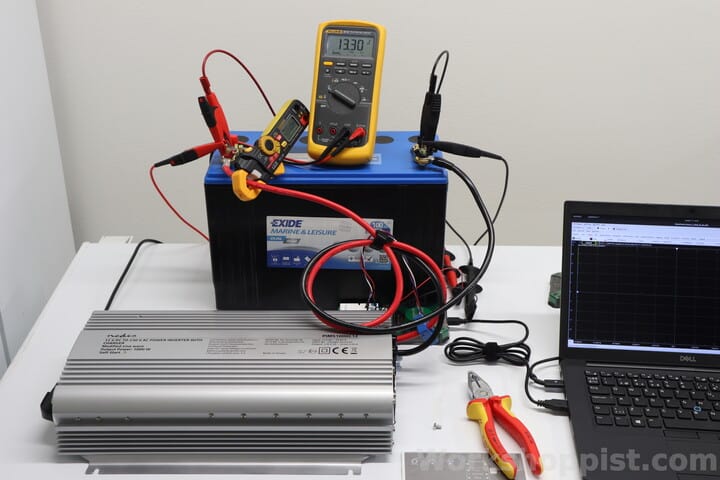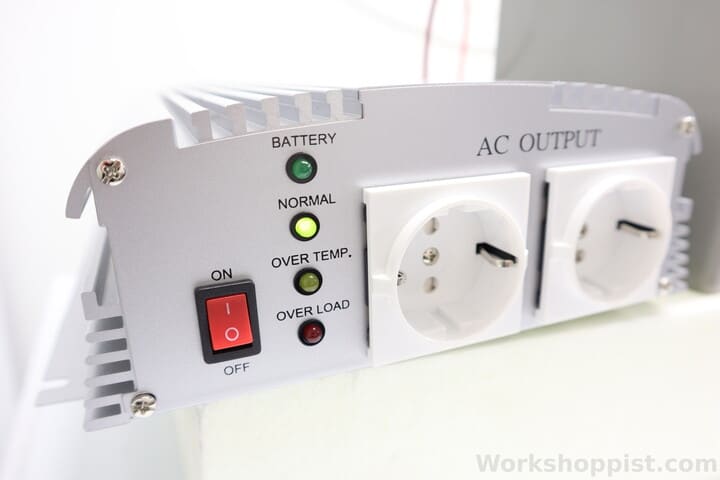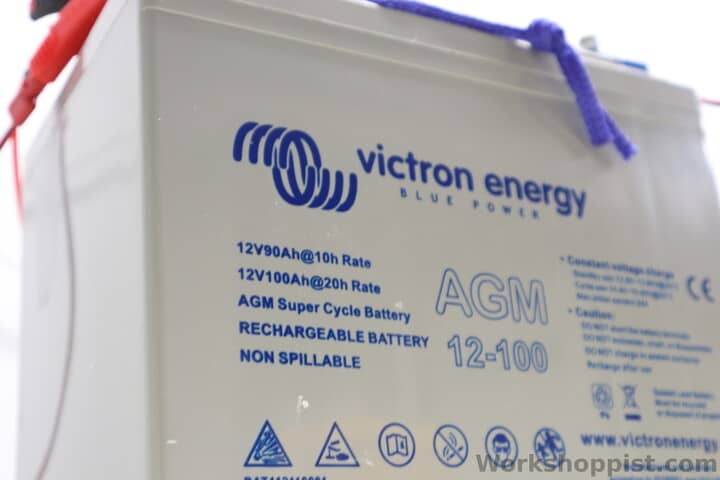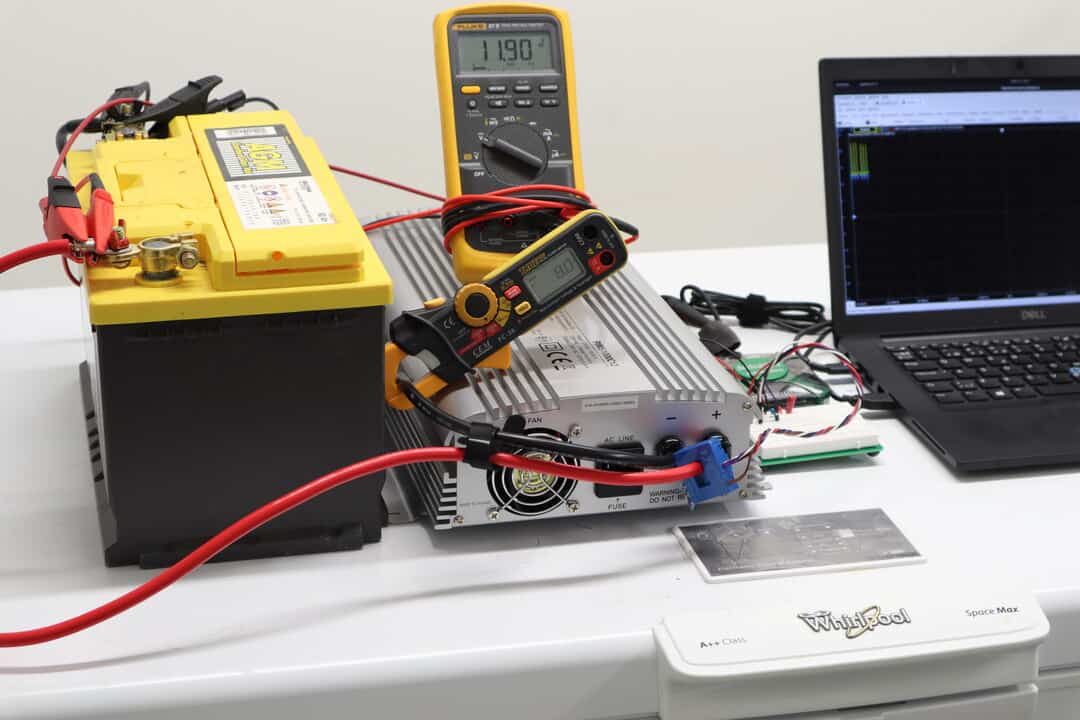Whether on a boat, RV or at a solar-powered off-grid cabin, you often need to run freezers and fridges on battery power. This is possible using a power inverter that converts the 12…24V DC power into 115V AC (or 230VAC).
But how to actually do this? Which freezers and fridges can you power from batteries? What equipment do you need and how large batteries?
In this article series, I will tell you the essentials of off-grid freezing and refrigeration. In a nutshell: freezers and refrigerators can run on batteries through a power inverter, but require a high-power inverter with a continuous power rating of 1000W to 4000W and 150Ah to 400Ah of 12V deep-cycle battery capacity for each day of runtime. Powering requirements depend on the freezer or refrigerator size, type, model and use cycle, and are not entirely apparent from the manufacturer specifications.
I learned the hard way that the manufacturer specs and commonly shared advice is unreliable and leads you to undersize your inverter and battery capacity. The info I share here is based on my own tests and measurements, and I hope it will save you time, money and frustration.
This first part of the series gives you an overview: which freezers/fridges work the best, what kind of an inverter, what kind of batteries you need. We will also shortly discuss how the energy source plays into the equation. The next part will look deeper into inverter sizing, while the third part focuses on batteries.

Battery power system components
The photo above shows what you need to run a refrigerator or a freezer on batteries. That is essentially:
- Freezer or fridge(-freezer): pick any model but consider energy use (see below).
- Battery pack: the storage of electrical energy. Typically multiple 12V flooded lead-acid, AGM or LiFePO4 (e.g. Battle Born), total capacities 200Ah and up.
- Power inverter: transforms the battery 12V or 24V DC power to 120V/60Hz AC power
- Energy source: something to recharge the batteries – solar, wind, micro-hydro, generator, engine alternator, shore AC power. (Not in the image.)
Choosing a Freezer/Fridge for battery power
Any fridge or freezer can be powered from batteries. In principle, you can choose a fridge or freezer for off-grid use just as you would for a grid-connected home: based on the capacity, form factor, and special functionality (auto-defrost, icemaker, etc.).
But: energy saving models make sense off-grid. To save you batteries and sparse off-grid energy (e.g. solar), it worthwhile to add energy-efficiency high on the priority list – much more so than in a grid-connected home.
A motivation: Compared to a wasteful side-by-side, an energy-efficient bottom-freezer fridge may save you $1000 or 350 lb. worth of battery capacity*.
*Assumed: 250 vs. 500 kWh/a, 3d autonomy, $1.50/Ah, 0.6lb/Ah AGM batteries
Check the energy use
Specifically, you want a cooling appliance with a low yearly energy use in kilowatt-hours (kWh). Look for the kWh number on the yellow Energy Guide (US), the Energuide (CA), Energy Label (EU and UK), or Energy rating label (AU).
As of 2021, an energy use around 200 kWh/a is the lowest you will find for any fridge or freezer – the best small-to-medium chest freezers and small refrigerators with no freezer or a top/bottom freezer may get this low.
At the other extreme, the most power-hungry units are at around 800 kWh/a; these are invariably large side-by-side or French-door refrigerator-freezers.
For a more fine-grained breakdown of energy use by freezer or fridge type and size, check the third part of this series.

Power inverters for freezers/refrigerators
Some bad news: refrigerators and freezers are tough to drive for the power inverter, and require a much more powerful inverter than you would think.
Continuous power rating
The table below shows the recommended minimum inverter continuous power specs for the different freezer and refrigerator-freezer types. The numbers are based on my own tests and measurements. I have also included a link to an inverter at Amazon as an example (Workshoppist.com is an Amazon Associate. As an Amazon Associate we earn from qualifying purchases.)
| INVERTER POWER required minimum Appliance type | Power (cont.) [W]* |
|---|---|
| Freezer, small Fridge, freezerless | 1500W |
| Freezer, medium-large Fridge-freezer, medium | 2500W |
| Fridge-freezer, large | 4000W |
| *(link to example at Amazon) |
Note that these are rough ballpark numbers – before buying the inverter, check the specs of the freezer or fridge you have selected, and calculate a better estimate using the formulas in my next article.
It’s all about starting current
Why such high powers? The sole reason for the high inverter power fridges and freezers require is the high starting current the compressor draws at each startup. This current, often called surge current, creates a very high power demand spike, which easily overloads and trips the inverter.
The surge power of freezers and refrigerators is commonly quoted at 3 to 5 times the running power. I have found this to be dramatically underestimating: the spikes I have measured (see next part) have been around 15x the running power in reality – more than 1000W for a duration of 1…1.5 seconds even for small freezers.
A case in point: I found a 100W freezer tripping a 600W inverter to overload every single start. This was despite a separate 1000W (!) surge power rating on the inverter.
The actual running power of modern freezers and fridges is actually low: 75W to 350W is typical. The running power can be ignored in inverter sizing (except in estimating the surge power, see next article).
Modified vs. Pure Sine
Power inverters come in two variants. Pure sine (wave) inverters reproduce the sinusoidal AC voltage waveform more precisely, but are bulkier and more expensive. Modified sine (wave) inverters output a rougher waveform, but are only 1/3 the price and weight of pure sine models.
Most freezers and fridges work with modified sine – this is true of all models I tested. New and smart appliances may still require a pure sine inverter – testing is sadly the only way to find out for sure.
For more info on sizing the inverter, check my separate article on this topic. Getting the inverter size just right will save you money and system weight.

Batteries for freezers and fridges
Freezers and refrigerators are also demanding for the battery pack, but for a different reason.
The fact that these cooling appliances are always on leads to large energy consumption over hours and days. In practice, most fridges and freezers will drain hundreds of amp-hours of battery capacity in 24 hours.
Battery type
All battery types common in off-grid power systems – flooded lead-acid, AGM and lithium-based – work well with freezers and refrigerators. None of these batteries have issues in putting out the surge power at compressor startup or the steady running power; at these power levels, the inverter is always the bottleneck.
Deep cycle vs. Starting: Lead-acid batteries come tailored for a few different use cases. Just as with off-grid power in general, prefer deep cycle batteries for running fridges and freezers. These batteries are intended for being discharged by 50% or even more before the next charging cycle; in other words, they will deliver lots of amp-hours. Starting batteries are optimized for maximal cranking amps and will be damaged if you discharge them even to 50%.
Note that if you go with lithium batteries (Battle Born or similar), you need substantially less nominal amp-hours than with any lead-acid battery type.
Battery pack size
As a rule of thumb, prepare for having 150Ah to 400Ah of nominal 12V lead-acid or AGM battery capacity per 24h of freezer or fridge runtime. The low end is enough for small energy-efficient chest freezers and refrigerators, while the high end is needed for biggest consumers – large side-by-side and French door fridge-freezers.
The table below roughly indicates the 12V battery Amp-hours you need for a 24h runtime for different fridge and freezer types. The amp-hour numbers are for lead-acid batteries (flooded or AGM); for lithium, you can halve the numbers. I have also included a link to an AGM unit (or pack) at Amazon to give you an example. More accurate sizing rules in a follow-up post.
| BATTERY CAPACITY for 24h runtime Appliance type | Capacity, nominal* 12V [Ah] |
|---|---|
| Freezer, chest Freezer, upright, small Fridge, freezerless Fridge-freezer, top/bottom small | 200Ah (AGM) |
| Freezer, upright large Fridge-freezer, top/bottom large Side-by-side, French door, medium | 300Ah (AGM) |
| Side-by-side, French door, large | 400Ah (AGM) |
| *(links to Amazon) |
The amount of battery capacity you should reserve depends on the freezer/fridge 1. energy use and 2. planned runtime required.
Energy use is quite easy to predict from the kilowatt-hours (kWh) number claimed in the Energy Guide (or equivalent) label. See the third part for more info.
Runtime
Planned runtime, also called days of autonomy, strongly depends on your use case and energy source: in a solar-powered off-grid house or cabin, 3 to 5 days is standard, but 24h is probably enough for RVs and boats that are connected to shore AC power every night.
| PLANNED RUNTIME ON BATTERIES Recommended Use case | Runtime |
|---|---|
| Off-grid property | 3…5 days |
| RV, boondocking | 3…5 days |
| RV/boat, day cruising | 18…24 h |
| Tailgating | 6…10 h |
The battery pack is easily going to be your biggest cost, so it makes sense to dimension it right. Check my follow-up article on battery pack sizing for formulas and tables!
Energy source
In the end, refrigerators and freezers will empty even the biggest battery packs in a few days, and you should consider the power source you are going to recharge the batteries from.
The topic of off-grid energy production is wide and outside the scope of this article, but a few points can be shortly made. The energy source plays into your freezer and refrigerator system design through two aspects:
- Average output (daily or three-day): sizes your fridge/freezer –determines how many watts your freezer or fridge can can draw on average
- Intermittency/availability: sizes your battery pack – how many hours or days of autonomy you have to prepare for
For most off-grid properties, the main energy source is going to be solar, but wind or micro hydro may also contribute. Some locations may use a generator as a backup or even a primary power source for recharging.
Mobile freezer and fridge installations on boats, RVs or vans, on the other hand, typically rely on nightly line power (“shore power”) connection to recharge, but may also charge from the engine alternator or solar power.
Conclusion
In this article we learned what you need running your freezer or fridge on battery power. We also got a rough idea of the inverter power and battery capacity you are going to need.
But if you want to optimize the inverter and battery power system, you should definitely check the other two parts of the series:
Part 2 will look deeper into inverter sizing. There I tell you how the commonly quoted power rules are wrong and give you formulas for better estimating the required inverter power.
Part 3 focuses on batteries, analyzing freezer and fridge power draw in detail and providing more accurate battery pack sizing rules.
